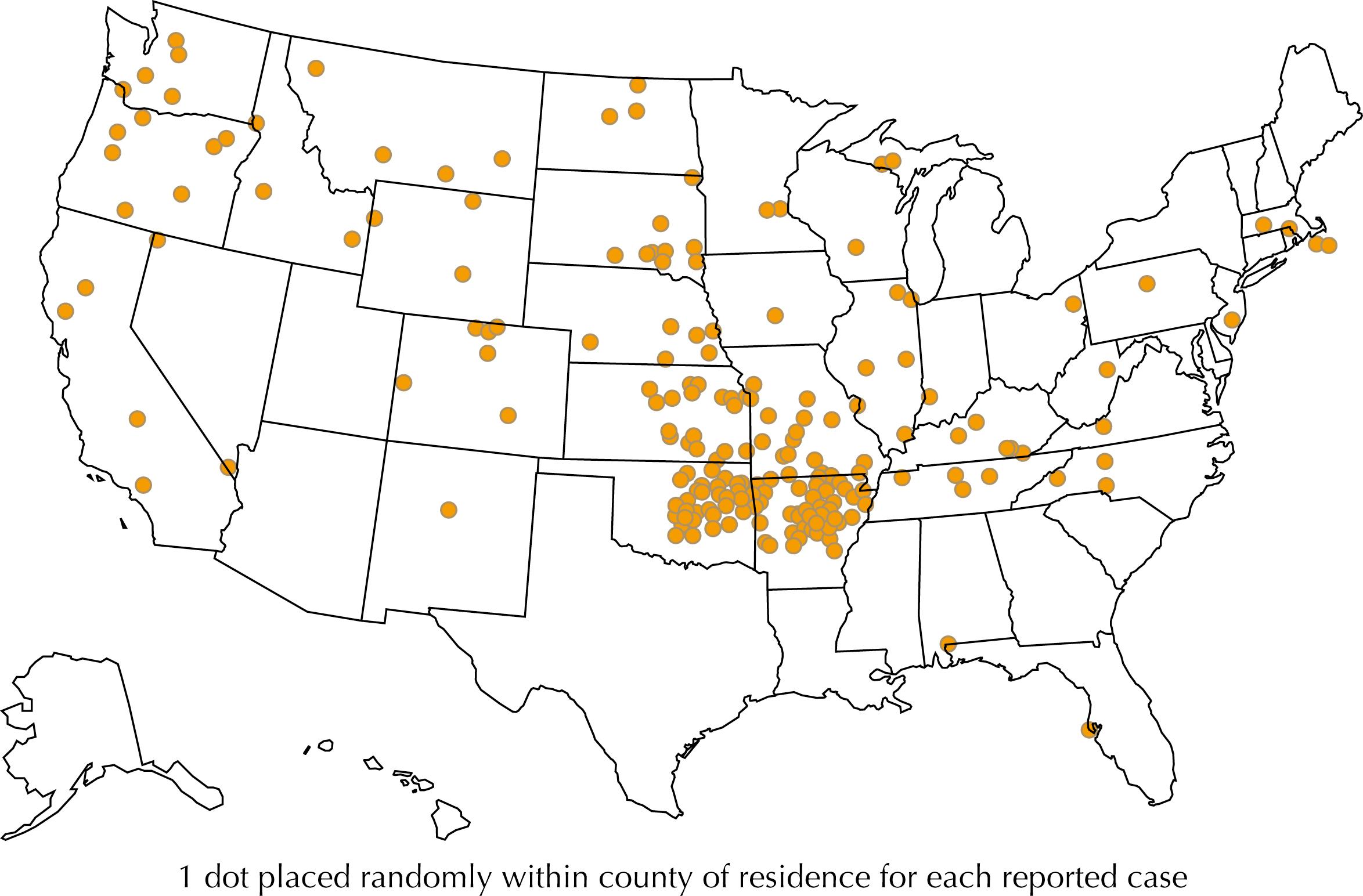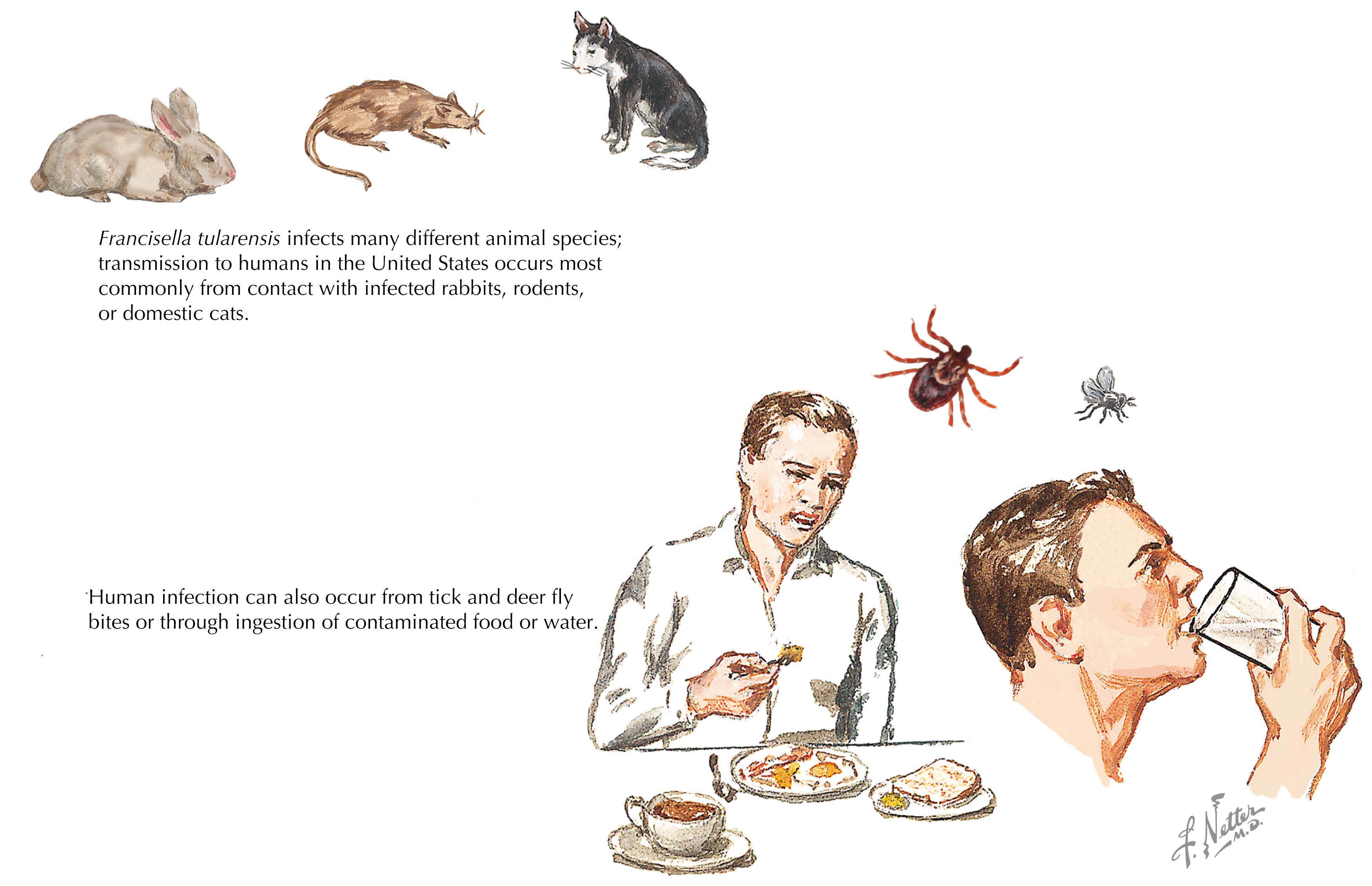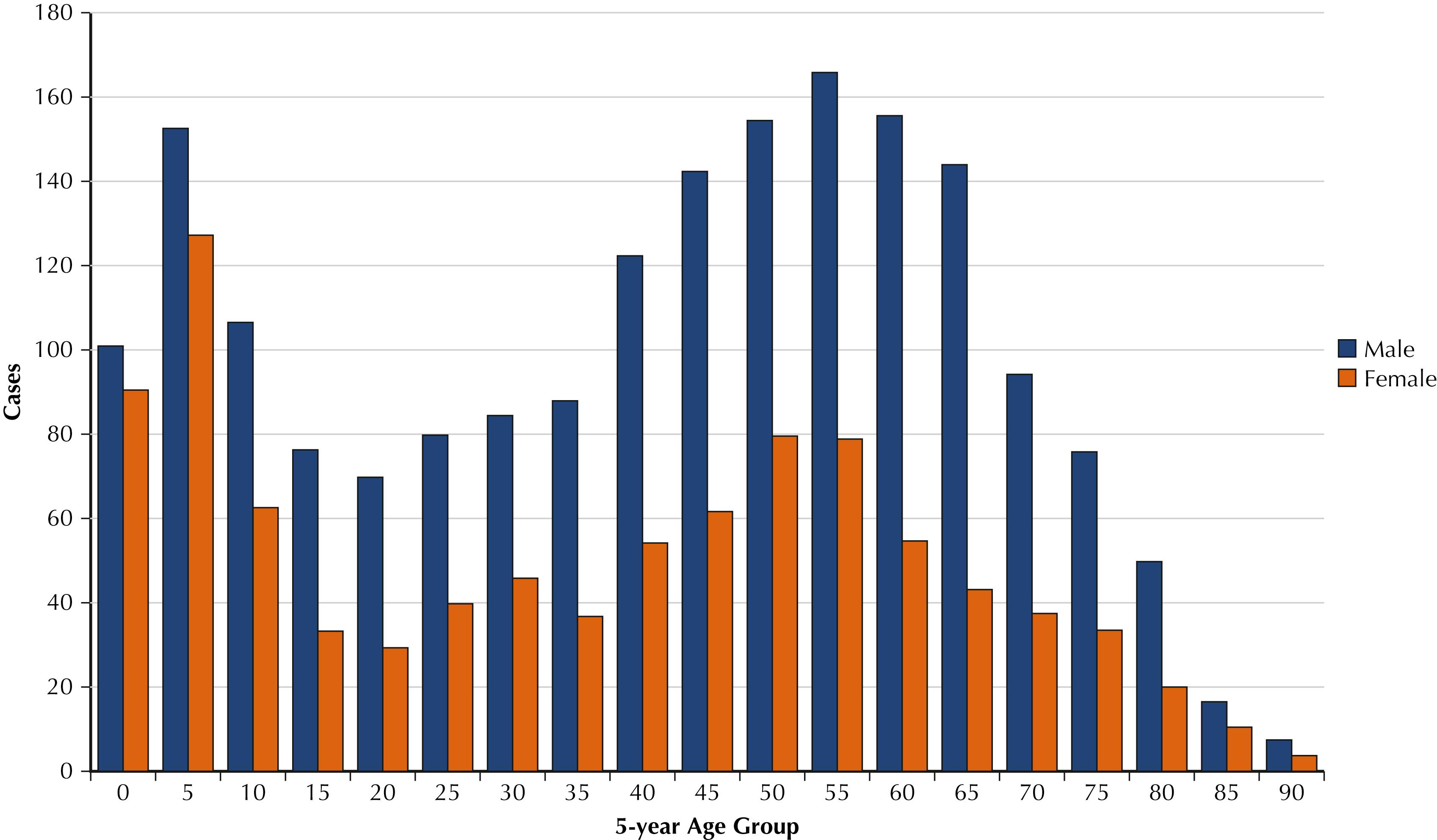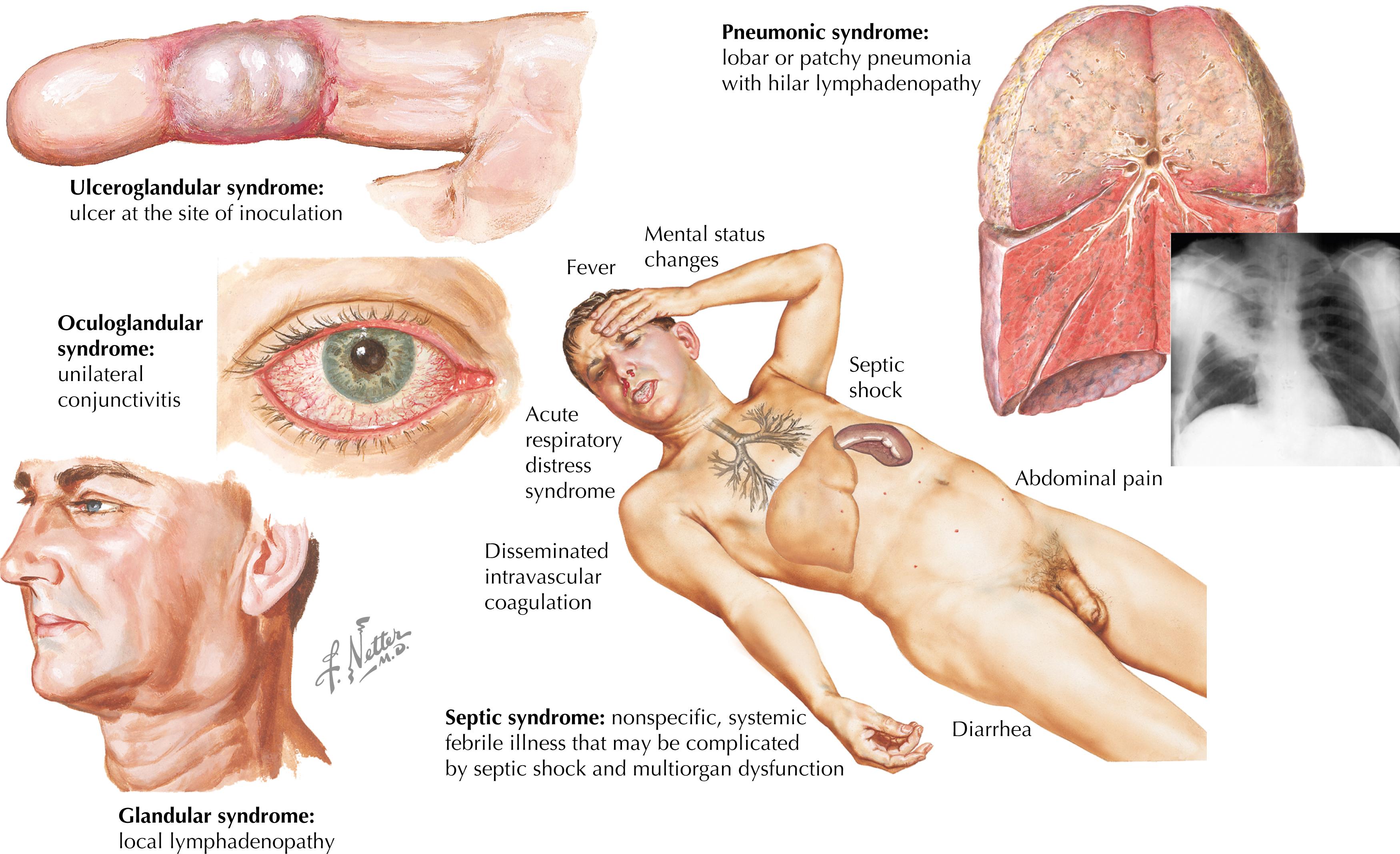Physical Address
304 North Cardinal St.
Dorchester Center, MA 02124
The authors would like to acknowledge Dr. Jo Hoffman who contributed to the previous edition of this chapter.
Tularemia is a zoonotic bacterial infection that occurs throughout the Northern hemisphere; it is caused by several subspecies of the gram-negative coccobacillus Francisella tularensis . A wide variety of animals can be infected with F. tularensis , and the bacteria can also be carried by insects. Human F. tularensis infection is acquired through contact with infected animals, by the bite of an infected insect, or through inhalation or ingestion of the bacteria, which are highly infectious. Thus tularemia is a human disease associated with outdoor activities, especially among hunters and trappers, and may be an occupational disease of landscape workers and gardeners. The severity of tularemia depends on the infecting subspecies of F. tularensis , the mode of disease transmission, and the size of the infecting inoculum. The spectrum of human F. tularensis ranges from mild, localized infection to life-threatening sepsis. Although F. tularensis is an uncommon human illness in the United States, because it is highly infectious, is easily transmissible, and causes severe or fatal illness, it is considered a potential agent of bioterrorism.
A 45-year-old male presents to your clinic in rural Arkansas with the complaint of fevers, chills, myalgia, and malaise which came on abruptly 1 day ago. These systemic symptoms were preceded by the development of a “red bump” on the patient’s right index finger that has now progressed to a painful blister. The patient’s medical history is significant for type 2 diabetes mellitus and hypertension, well controlled with once daily doses of metformin and lisinopril. The patient works as a roofer, and is an avid outdoors enthusiast, reporting that he has been out hunting and trapping each weekend for the past month. He smokes half a pack a day of cigarettes, and partakes in limited social alcohol use, but denies illicit drug use and recent travel. He has no known drug allergies. The patient’s vital signs include a temperature of 102.1°F, heart rate of 115, blood pressure of 110/80, and respiratory rate of 18, with room air pO2 96%. Physical examination reveals a generally unwell-looking middle-aged male, with a tender pustular lesion on the right index finger and right axillary lymphadenopathy to palpation, but no pulmonary or other systemic abnormalities are detected. Initial laboratory findings show leukocytosis, thrombocytopenia, as well as elevated AST, ALT, and creatinine. Gram stain of the patient’s blood does not reveal any organisms; however, the Francisella tularensis IgG/IgM enzyme-linked immunosorbent assay (ELISA) test shows detectable IgM-class antibodies. Chest x-ray does not reveal any findings significant for a pneumonic syndrome. The patient was admitted to the hospital with a presumptive diagnosis of ulceroglandular tularemia and started on gentamicin at 5 mg/kg/day intravenously (IV). Due to the patient’s elevated creatinine at admission, the drug was prescribed as three divided doses given every 8 h for a 10-day course. Further workup was sent to state laboratories for confirmatory testing including polymerase chain reaction (PCR), and the diagnosis of tularemia was confirmed. After 3 days of treatment, the patient had marked clinical improvement; however, the routine serum chemistry panel showed creatinine levels increased by 1.5-fold from time of admission. Given the concern for nephrotoxicity associated with gentamicin, the patient was transitioned to oral doxycycline 100 mg PO BID to complete 21 total days of treatment, and was discharged from the hospital on treatment day 7 after resolution of his acute kidney injury, with creatinine decreasing to his known pre-illness baseline, and continued clinical improvement, with strict return instructions for re-development of systemic infectious symptoms. The patient completed the course of antimicrobial therapy as an outpatient and made a full recovery.
COMMENT: Tularemia primarily occurs in rural settings and is a risk for hunters, trappers, and other outdoor enthusiasts who may come into contact with infected animals, their carcasses, or waste products; gardeners or landscapers may also be exposed to aerosols of contaminated soil. Most cases in the United States occur in the south central states including Arkansas, Missouri, and Oklahoma, but cases have been reported in every state except Hawaii. Very low inoculating doses of F. tularensis are capable of producing disease. The most feared complication of tularemia is pneumonic tularemia, occurring either due to inhalation of bacteria or by hematogenous spread from another site, which can rapidly progress to severe, multilobar pneumonia, acute respiratory distress syndrome, and death. If a diagnosis of tularemia is suspected, it is important to notify laboratory personnel so that they can use appropriate growth media for culture and ensure that correct biosafety measures are followed. While streptomycin has historically been the drug of choice for tularemia, due to its limited availability it is rarely used, and gentamicin has been recommended for therapy in all adults, including pregnant women, and children.
Tularemia, also known as rabbit fever or deer fly fever , is a zoonosis caused by a highly infectious, aerobic, gram-negative coccobacillus, F. tularensis . The natural reservoir for F. tularensis is small mammals such as rodents or rabbits. The bacterium is found throughout host animals in most of North America and Eurasia. In the United States, tularemia is most commonly caused by two subspecies of F. tularensis: F. tularensis subsp. tularensis (type A, which is subdivided into subtypes A1a, A1b, and A2), and F. tularensis subsp. holarctica (type B). In Europe and Eurasia, F. tularensis subsp. holarctica is the primary cause of tularemia. Human tularemia was first described in the United States in 1910 as “deer fly fever,” and the causative agent (at that time known as Bacterium tularense ) was identified after an outbreak of a plague-like illness of ground squirrels in Tulare County, California in 1911. In 1924, a United States Public Health Service physician, Edward Francis, identified B. tularense as the cause of human deer fly fever. To honor his contributions to the understanding of this organism, the bacterium was subsequently renamed F. tularensis .
In the United States, human tularemia is rare but has been documented in every state except Hawaii. Tularemia was much more common in the early part of the 20th century than it is now ( Fig. 91.1 ). Since 2000, most cases of tularemia have been reported from rural areas of the United States where infection of host animals is common (or enzootic), such as Arkansas, Kansas, Nebraska, and Missouri. In addition, many cases are reported from Martha’s Vineyard, Massachusetts, where hunting clubs imported infected rabbits from enzootic areas in the 1920s and 1930s ( Fig. 91.2 ). In 2018, the Centers for Disease Control and Prevention (CDC) received 229 reports of human tularemia, and from the years 2008 to 2018 there have been approximately 205 infections reported per year. Although the global incidence of tularemia has decreased markedly over the past 50 years, periodic outbreaks continue to occur, especially in Northern Europe and Eurasia. These outbreaks have been associated with drinking spring water, hunting, and other outdoor activities, and some have involved hundreds of cases of tularemia. Although rare in humans, tularemia occurs in a wide variety of animals and is maintained in an enzootic cycle with rodents and lagomorphs. Other animals, such as cats and nonhuman primates, may serve as incidental hosts. Outbreaks, or epizootics, of tularemia periodically occur in animal populations and may herald outbreaks of human disease.


The animals most commonly associated with transmission of tularemia to humans in the United States include lagomorphs (rabbits and hares) and rodents (voles, squirrels, muskrats, and beavers). Although animals are the primary reservoir of F. tularensis , the infection can also be transmitted by insect bites (especially those of ticks or deer flies) or by contact with bacteria in the environment. Francisella tularemia tularensis is a hardy organism that can survive for extended periods in water, mud, and frozen animal carcasses. Tularemia has been reported after skin or mucous membrane contact with contaminated animals or their environment, ingestion of contaminated food or water, and inhalation of aerosolized bacteria ( Fig. 91.3 ). Activities associated with risk of tularemia include hunting, trapping, dressing, eating, or handling infected animals; activities that result in exposure to infected insects; farming or gardening with machinery that may aerosolize the carcasses of infected animals; and handling F. tularensis in a laboratory without appropriate personal protective equipment. Although inhalational tularemia does occur, the bacteria are not known to spread from person to person.

During and after World War II, several countries (including Japan, the former Soviet Union, and the United States) conducted research on the use of F. tularensis as a biologic weapon. More recently, most countries have suspended their biologic weapons research and destroyed their weapon stockpiles. However, as a highly infectious bacteria that can be easily mass-produced and aerosolized, with the potential to cause severe or fatal illness, F. tularensis continues to be designated a Category A Bioterrorism Agent by the CDC.
Recent CDC analyses of laboratory-documented human tularemia reported in the United States from 1964 through 2004 found that infections tend to be acquired during the warmer months (72% occurred from May through September) and are geographically diverse (type A1 infections cluster toward the eastern United States, type A2 infections occur toward the west, and type B is primarily clustered through the southern and central western areas of the country). Men constitute the majority of infections (74%), and younger age appears to be a risk for infections with type A, compared with type B (median age 38 vs. 50 years) ( Fig. 91.4 ). Overall, 6% of infections occurred among persons with an immunocompromising condition (e.g., malignancy, organ transplant, or human immunodeficiency virus [HIV] infection). A source of infection was reported for 42% of the cases, and in this subgroup, direct animal contact accounted for about half of all infections (47% of type A and 53% of type B). Among persons with infection associated with animal contact, 53% of type A infections were attributed to lagomorphs and 30% to cats. No persons with type B infection reported lagomorph contact; those infections were linked to either rodents (33%) or cats (22%). Tularemia attributed to insects accounted for 44% of type A infections and 29% of type B infections; among infections resulting from insect bites, tick exposure (87%) was reported more commonly than contact with deer flies. A small proportion of types A (8%) and B (18%) infections were associated with multiple exposures or landscaping activities.

The clinical presentation and severity of tularemia vary according to the anatomical portal of entry, the virulence of the F. tularensis strain involved, and the size of the bacterial inoculum; as few as 10 bacteria can cause human disease. The incubation period for tularemia is typically 3 to 5 days (range, 1 to 14 days). The clinical spectrum of tularemia is quite variable, ranging from localized infection to life-threatening systemic illness; forms include ulceroglandular, glandular, pneumonic, typhoidal, oculoglandular, pharyngeal, and septic syndromes ( Fig. 91.5 ). After entry of F. tularensis via skin or mucous membranes, the bacteria disseminate to local lymph nodes and subsequently spread via the bloodstream to additional lymph nodes and organs, primarily the spleen, liver, kidney, lungs, and pleura. Regardless of the form of infection, untreated tularemia may become chronic, with fever, malaise, weight loss, and adenopathy lasting months.

Tularemia most commonly manifests as ulceroglandular or glandular disease (about 60% to 80% of infections) that follows entry of the bacteria into disrupted skin from contact with an infected animal or via the bite of an infected insect. A papule appears at the site of inoculation and, similar to other presentations of tularemia, the skin lesion is usually accompanied by the abrupt onset of symptoms of a systemic disease: chills, fever, headache, malaise, and myalgias. The skin lesion becomes pustular and tender with local lymphadenopathy, then ulcerates and may develop an eschar; the involved lymph nodes may become fluctuant and suppurate. In glandular tularemia, a less common form, a skin or mucosal lesion is not apparent.
About 15% of naturally infected persons have pneumonic tularemia, which may result from inhalation of bacteria or by hematogenous spread from another site. The occurrence of atypical infections, either in terms of clinical presentation or geographic location, and temporal clusters of pneumonic tularemia might indicate an act of deliberate infections. Typical signs and symptoms are similar to those of community-acquired pneumonia including fever, cough, and dyspnea. In early pneumonic tularemia, chest radiographic imaging may show nonspecific changes consistent with pneumonia such as diffuse peribronchial infiltrates that progress to patchy or lobar involvement with pleural effusions and perihilar lymphadenopathy. However, many patients demonstrate systemic findings alone and lack significant pulmonary involvement. In one study in which volunteers were intentionally exposed to aerosolized tularemia, up to 75% had no pulmonary signs or symptoms at the onset of illness. However, more serious complications can occur following pneumonic tularemia such as septic shock, acute respiratory distress syndrome, respiratory failure, and death. Less common presentations of tularemia include typhoidal (a systemic illness that does not involve specific organs or lymph nodes and lacks an obvious site of inoculation), oculoglandular (inoculation of the conjunctiva with mucosal ulceration and local lymphadenopathy), and oropharyngeal (ingestion of bacteria followed by oropharyngeal mucosal ulceration and local lymphadenopathy). Although rare, sepsis is the most serious form of tularemia, a systemic illness that may rapidly progress to shock, multisystem organ failure, and death.
Laboratory findings in tularemia are nonspecific and may include mild leukocytosis with normal differential hemoglobin and platelet counts are typically normal, the nonspecific markers of inflammation erythrocyte sedimentation rate and C-reactive protein are elevated, as well as abnormalities associated with multiorgan dysfunction, including elevated serum aminotransferases and creatine kinase.
Become a Clinical Tree membership for Full access and enjoy Unlimited articles
If you are a member. Log in here